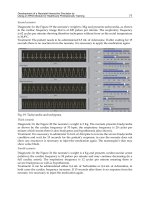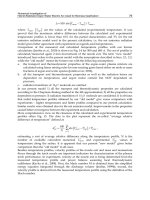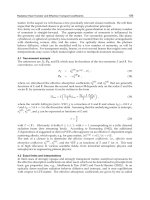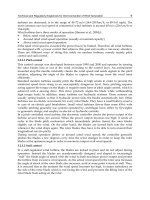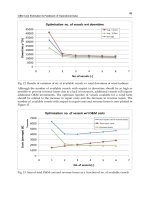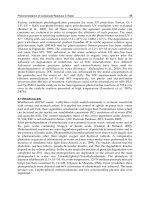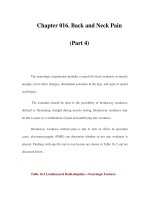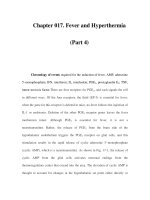Chapter 070. Nutritional Requirements and Dietary Assessment (Part 4) potx
Bạn đang xem bản rút gọn của tài liệu. Xem và tải ngay bản đầy đủ của tài liệu tại đây (12.9 KB, 5 trang )
Chapter 070. Nutritional Requirements
and Dietary Assessment
(Part 4)
Estimated Average Requirement
When florid manifestations of the classic dietary deficiency diseases such
as rickets, scurvy, xerophthalmia, and protein-calorie malnutrition were common,
nutrient adequacy was inferred from the absence of their clinical signs. Later, it
was determined that biochemical and other changes were evident long before the
clinical deficiency became apparent. Consequently, criteria of nutrient adequacy
are now based on biologic markers when they are available. Priority is given to
sensitive biochemical, physiologic, or behavioral tests that reflect early changes in
regulatory processes or maintenance of body stores of nutrients. Current
definitions focus on the amount of a nutrient that minimizes the risk of chronic
degenerative diseases.
The EAR is the amount of a nutrient estimated to be adequate for half of
the healthy individuals of a specific age and sex. The types of evidence and
criteria used to establish nutrient requirements vary by nutrient, age, and
physiologic group. The EAR is not useful clinically for estimating nutrient
adequacy in individuals because it is a median requirement for a group; 50% of
individuals in a group fall below the requirement and 50% fall above it. Thus, a
person with a usual intake at the EAR has a 50% risk of an inadequate intake. For
these reasons, other standards, described below, are more useful for clinical
purposes.
Recommended Dietary Allowances
The RDA is the nutrient-intake goal for planning diets of individuals; it is
used in the MyPyramid food guide of the U.S. Department of Agriculture
(USDA), therapeutic diets, and descriptions of the nutritional content of processed
foods and dietary supplements. The nutrient content in a food is stated by weight
or as a percentage of the daily value (DV), a variant of the RDA that, for an adult,
represents the highest RDA for an adult consuming 2000 kcal/d.
The RDA is the average daily dietary intake level that meets the nutrient
requirements of nearly all healthy persons of a specific sex, age, life stage, or
physiologic condition (such as pregnancy or lactation).
The RDA is defined statistically as 2 standard deviations (SD) above the
EAR to ensure that the needs of most individuals are met.
The risk of dietary inadequacy increases as intake falls further below the
RDA. However, the RDA is an overly generous criterion for evaluating nutrient
adequacy. For example, by definition the RDA exceeds the actual requirements of
all but about 2 to 3% of the population. Therefore, many people whose intake falls
below the RDA may still be getting enough of the nutrient.
Adequate Intake
It is not possible to set an RDA for some nutrients that do not have an
established EAR. In this circumstance, the AI is based on observed, or
experimentally determined, approximations of nutrient intakes in healthy people.
In the DRIs established to date, AIs rather than RDAs are proposed for infants up
to age 1 year, as well as for calcium, chromium, vitamin D, fluoride, manganese,
pantothenic acid, biotin, choline, sodium, chloride, potassium, and water for
persons of all ages.
Tolerable Upper Levels of Nutrient Intake
Healthy individuals derive no established benefit from consuming nutrient
levels above the RDA or AI. Excessive nutrient intake can disturb body functions
and cause acute, progressive, or permanent disabilities. The tolerable UL is the
highest level of chronic nutrient intake (usually daily) that is unlikely to pose a
risk of adverse health effects for most of the population. Data on the adverse
effects of large amounts of many nutrients are unavailable or too limited to
establish a UL. Therefore, the lack of a UL does not mean that the risk of adverse
effects from high intake is nonexistent. Individual nutrients in foods that most
people eat rarely reach levels that exceed the UL. However, nutritional
supplements provide more concentrated amounts of nutrients per dose and, as a
result, pose a greater potential risk of toxicity. Nutrient supplements are labeled
with "Supplement Facts" that express the amount of nutrient in absolute units or as
the percent of the DV provided per recommended serving size. Total nutrient
consumption, including both food and supplements, should not exceed RDA
levels.[newpage]
Factors Altering Nutrient Needs
The DRIs are affected by age, sex, rate of growth, pregnancy, lactation,
physical activity, composition of diet, coexisting diseases, and drugs. When only
slight differences exist between the requirements for nutrient sufficiency and
excess, dietary planning becomes more difficult.
